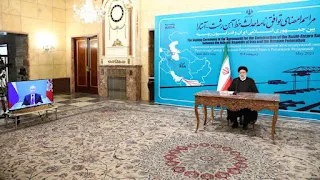On Wednesday, Russia and Iran signed an agreement to build a railway along the Caspian Sea coast, which will complete the land link between the two countries. While observers believe that this new line will be the main competitor to the Suez Canal, as a passage for transporting goods from East Asia to North and West Europe.
At a meeting of the Iranian Transport Ministers, Mehrdad Bazarbash, and the Russian Vitaly Saveliev, in Tehran on Wednesday, an agreement was signed to construct a new railway line along the Caspian Sea coast, which will enable the completion of the railway link between the two countries, and will link the Russian and Iranian ports to the Indian and Azeri railway network.
While the new line falls within the framework of the "North-South Corridor" logistical project between Russia and Iran, these specifications qualify it to constitute a basic passage for goods from East Asia to North and West Europe, which makes it the main competitor to the Suez Canal, as it shortens time and reduces transportation costs.
Iran-Russia train
This new line will extend for 162 kilometers, linking the cities of Rasht on the southern coast of the Caspian Sea and Astar on the border with Azerbaijan, and from there it will be connected to the Azerbaijani train network that is mainly connected to the Russian network. The project to construct this line will cost 1.6 billion dollars, and it will be a key to transporting goods through the international transport corridor between the north and the south.
The signing ceremony was attended by Iranian President Ibrahim Raisi, as well as by Russian President Vladimir Putin via visual communication technology. And the Iranian president described this project as "undoubtedly an important and strategic step in the direction of cooperation between Tehran and Moscow."
While his Russian counterpart Vladimir Putin said , “The unique transport artery between north and south, of which the Rasht-Astara railway will become a part, will help to significantly diversify global traffic flows,” and will contribute to “connecting Russian ports on the Baltic Sea with Iranian ports.” in the Indian Ocean and the Gulf.
And last March, Russian Foreign Minister Sergey Lavrov announced, during his visit to the Azerbaijani capital, Baku, the practical start of extending the railway to operate regular trains at the Rasht-Astara section, within the north-south corridor project.
And before that, last January, Iranian Minister of Transport and Urban Development Mehrdad Bazarbash met with the special envoy of Russian President Igor Levitin to review progress in railway cooperation between the two countries. At that time, Bazarbash emphasized accelerating the development of the international north-south transit corridor.
May compete with the Suez Canal?
The Rasht-Astara railway project is an important step in the levels of economic cooperation between Moscow and Tehran, as well as in the development of the logistical transport network between East Asia towards Western Europe, as it is an important link between India, Iran, Russia, Azerbaijan and other countries via rail and sea. Russia says this line can compete with the Suez Canal as a major global trade route .
The "North-South" corridor consists of a network of sea, land and railway lines with a length of 7,200 km, and starts from Bombay in India to connect the Indian Ocean and the Gulf region with the Caspian Sea, passing through Iran, and then heading to St. Petersburg, Russia, and from there to northern Europe, reaching the capital. Finnish, which shortens the distance compared to the Suez Canal by more than double, reducing shipping time and cost.
In addition to this, the pipeline will represent an economic escape for the two countries, which are under harsh Western sanctions, on top of which are Russian energy exports. In this regard, and last July, Iran witnessed the arrival of the first shipments of Russian fuel via the freight train linking it to Azerbaijan.
This is confirmed by Vladimir Tsyganov, Head of the Transportation Systems Development Projections Department at the Institute of Transportation Issues of the Russian Academy of Sciences, in a previous press interview , by saying that deciding on the issue of extending the railway in Iran and speeding up the realization of the project coincides with Russia’s search for solutions to circumvent sanctions. and Western economic constraints, which have not yet affected the freight sector by rail and trains.
On the other hand, according to an article by the writer and consultant on energy affairs, Amoud Shukri, this line will contribute to increasing trade exchanges between Iran and Russia, and thus "would give Tehran a better position in economic negotiations with other Central Asian countries," as Iran could benefit of trade with these countries "using oil and gas exchanges for other commodities or energy resources".
Trade exchanges between Russia and Iran witnessed a remarkable increase during the first seven months of 2022, by about 44.9%. The total of these exchanges during that period amounted to 2.8 billion dollars, and Russia aims to raise these exchanges to 40 billion dollars in the coming years.
Tags:
asiawest





